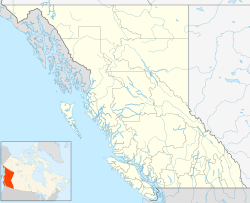world.wikisort.org - Canada
Kitwanga /ˈkɪtwəŋɡə/ or Gitwangak or Gitwangax ("people of the place of rabbits" in the Gitxsan language) is located where the Kitwanga River runs into the Skeena River in British Columbia. A long-standing village before contact, the village is within Gitwangak Indian Reserve No. 1.[2]
It has been suggested that Gitwangak Battle Hill National Historic Site be merged into this article. (Discuss) Proposed since May 2022. |
Kitwanga
Gitwangax Gitwangak | |
|---|---|
Unincorporated community | |
 Totem poles with homes in the background | |
 Kitwanga Location of Kitwanga. | |
| Coordinates: 55°6′0″N 128°4′0″W | |
| Country | Canada |
| Province | British Columbia |
| Region | Skeena |
| Regional district | Kitimat–Stikine |
| Population (2016)[1] | |
| • Total | 430 |
| Time zone | UTC-8 (PST) |
| • Summer (DST) | UTC-7 (PDT) |
| Highways | |
| Waterways | Skeena River |

There is recreational salmon fishing (chinook, coho, pink, sockeye and steelhead). The community is governed by a local band office. As of the current census the population of Kitwanga is approximately 480[3] and is primarily a small town made up of patriarchal families like the Ranahans Harris, fallers Faulkners Daniels and the Spooners.
National Historic Site of Canada
The totem poles of Gitwangak village are a National Historic Site of Canada, as is nearby Kitwanga Fort.
The Gitxsan Nation is made up of:
- Kitwanga (Gitwangak)
- Kispiox (Anspayax)
- Glen Vowell (Sik i dak)
- Old Hazelton (Gitanmaax)
- Gitsegukla, also spelled Kitseguecla or Kitsegukla
- Cedarvale (Meanskaniist or Minskinish,).
- 'Ksan (living museum/historical village)
Directions
North of Kitwanga stands Meziadin Junction (156), Stewart (221), and Dease Lake (488). West of Kitwanga is Terrace (91), Kitimat (149), and Prince Rupert (235). And East of Kitwanga is New Hazelton (48), Witset (81), Smithers (112), Telkwa (129), and Prince George (482).
Notable residents
- Judith P. Morgan, painter[4]
See also
- Gitwangak Battle Hill National Historic Site
- Kitwanga Mountain Provincial Park
- Kitwanga railway station
- Kispiox
- Hazelton
- Tsimshian
- Nisga'a
References
- BC Names/GeoBC listing "Kitwanga (community)"[permanent dead link]
- "Gitwangak 1, Indian reserve [Census subdivision], British Columbia and British Columbia [Province]". Census Profile, 2016 Census. Statistics Canada. August 9, 2019. Retrieved July 16, 2020.
- BCGNIS entry "Gitwangak Indian Reserve 1"[permanent dead link]
- "Community Futures 16/37 | Community Profiles | Kitwanga & Area". www.1637cfdc.bc.ca. Retrieved 2015-12-24.
- Gallery, Belkin. "Judith Morgan". Retrieved 10 February 2017.
External links
 Kitwanga travel guide from Wikivoyage
Kitwanga travel guide from Wikivoyage- Google Map photo of Kitwanga
Другой контент может иметь иную лицензию. Перед использованием материалов сайта WikiSort.org внимательно изучите правила лицензирования конкретных элементов наполнения сайта.
WikiSort.org - проект по пересортировке и дополнению контента Википедии